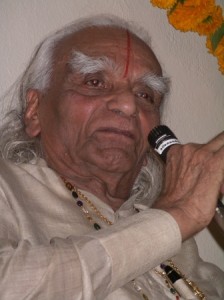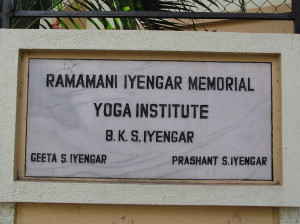Guruji will be 95 years young in a month. He is alert, sharp, warm, and loves his granddaughter, Abhijata, and great granddaughter, Satvika, immensely. Shri BKS Iyengar and Geetaji have been mentoring Abhijata for almost ten years now. Abhijata accompanied Geetaji to the National Iyengar Yoga Convention in Las Vegas in 2005 and she assisted in the Therapeutics Convention in Portland in 2010. She has a master’s degree, and is married to a computer wizard with the surname Iyengar. The extended family is supporting the next generation of Iyengar yoga by joining the Iyengar family daily in the home compound behind the Institute. While Abhijata practices with Guruji and teaches her classes, her father, Shridhar, and mother, Suchita, look after the baby.
Every day, baby Satvika visits the asana room on Shridhar’s shoulder. Guruji takes her upside down and into Chakorasana, or a somersault, while Mom (Abhijata) and most of the students in the room look on, all gooey eyed. Guruji face loses thirty years when he smiles at his great granddaughter. Their love affair is infectious, and is generously shared with everyone, local and foreign students alike.
Yesterday I ran into Guruji downstairs, in the main lobby. It was mid-day, there were very few people around. He called me over and asked how I was. He told me that he had not been sure whether he would make it through this most recent upper respiratory infection; and showed me how the skin on his for arm was now firm and hydrated. “Like a withered flower Guruji, you have now been watered back to health”. He laughed; his spirits bright, his smile kind. He has lost a lot of weight since I saw him sixteen months ago. His eye brows are now snowy white, wild, and just as expressive as ever.
This morning he idled into the asana practice hall. An hour later, he had the robust assistant Raya and Abhijata huffing and moaning their way through backbends. He then proceeded to place his tailbone precisely on the trestle and arch over it lengthwise, bending backward until his spine was parallel the floor. His heels pressed firmly down, his breath quiet, his body so supple and stable. When he came out of the pose, he chided the youngsters. Fortunately, there was a camera to document the event. It is such amazing moments that keep me coming, despite all odds and the many other wonders I might be interested in this world. This master has touched my life with his courage, his integrity, and his adherence to the highest standards possible in yoga.
Later today he joined the team in the therapeutics class, supervising students with heart, back, knee, and neck conditions. His is strong medicine to vanquish any manifestation of illness, whether it resides in the physical body or has roots in the psyche. As he has so eloquently stated in the past: “yoga will teach you to cure what need not be endured and to endure what cannot be cured”.







